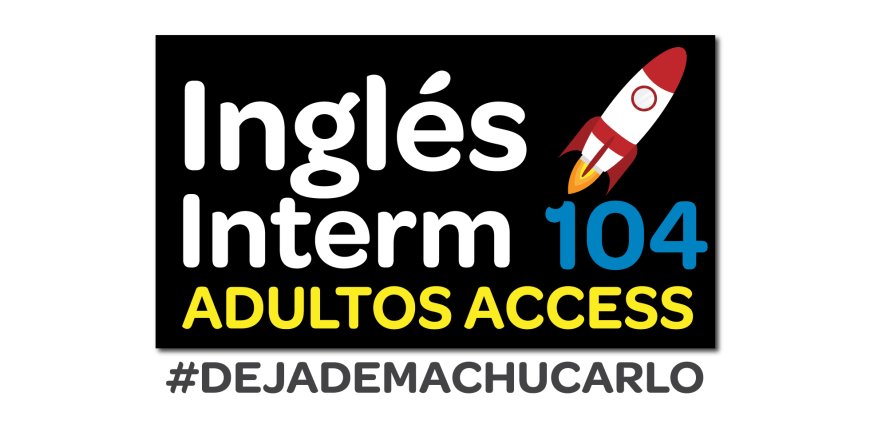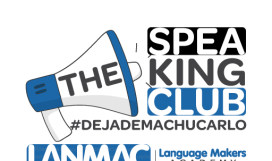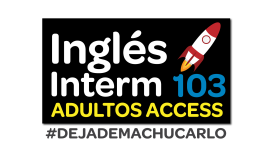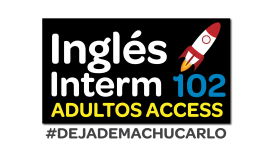Inglés Intermedio Adultos Access 104

The Inglés Intermedio Adultos Access 104 is a program designed for those 15 years of age and older. It is the third intermediate level of our program (as a requirement you must have completed the int level 103 or taken a placement test). It combines the fundamental elements of the language in a timely manner so that the student will be able to use the language immediately. All available content will be in English as we use the inverted classroom methodology and the communicative method.
The inverted classroom methodology or Flipped Classroom is the concept that the student can obtain information in a time and place that does not require the teacher’s physical presence. It is a new pedagogical model that offers a comprehensive approach to increasing student engagement and involvement in learning, making them part of its creation, and allowing the teacher to give more individualized treatment. Consequently, you will see the content before your encounter with the teacher.
Advantages of this methodology:
- You are the protagonist
- Use of technology and web platforms
- Consolidates knowledge
- Encourages diversity in the classroom
- More profound and more lasting learning over time
- Improves the development of competencies through individual and collaborative work
This allows the meetings to be more focused on speaking, using the communicative method or CLT, which is an approach to language teaching that prioritizes oral language interaction.
Welcome to the bilingual world!
B3 Lesson 1A
These are the objectives of lesson 1A that include topics such as, relative clauses with who and that, and describing personalities.
In this activity students have to watch the video to learn how to use the relative pronouns who, that and which as subject and objects of relative clauses.
In this activity students have to complete the conversation with who or that. Put an ✗ when a relative pronoun isn’t necessary.
In this activity students have to fill in the boxes with the correct relative pronouns who or which to complete the sentences.
In this activity student have to choose the correct relative pronoun (who, that, which) to complete the sentences in the interactive video.
In this activity students have to study the cards to learn the different adjectives that are commonly used to describe people's personalities.
In this activity students have to complete the descriptions dragging the correct adjectives from the list.
In this activity students have to find the personality traits adjectives to describe people, from the grid. This helps memorize words faster
In this activity students have to match the adjectives with their definitions by dragging the words into the correct boxes.
In this activity students have to read an article about an ideal partner and then solve some exercises about it.
B3 Lesson 1B
These are the objectives of lesson 1B that include topics such as discussing likes and dislikes about situations and how to use adverbial clauses with when.
In this activity students have to watch the video to learn how to form and when to use if/when clauses (adverb clauses).
In this activity students have to match the 'it' clauses with the most suitable 'when' clauses.
In this activity students have to study the dialog cards and practice to learn IT clauses you could use in different situations.
In this activity students have to put the words in order to make sentences with it clauses and adverbial clauses with when.
In this activity students have to say these phrases out loud using your microphone. Make sure to use the correct pronunciation of the words.
In this activity students have to choose the correct word (personality trait adjectives) to complete the sentences.
In this activity students have to read an example of a person describing something that bothers them, and then record their own answer talking about sth that bothers them.
This is a short quiz that includes the topics seen in lesson 1A and 1B.
B3 Lesson 2A
These are the objectives of lesson 2A that include topics such as, how to use gerund phrases, discuss opinions of different jobs.
In this activities students have to watch the video to learn how to use gerund phrases as subjects and objects in sentences.
In this activity students have to complete the sentences with the correct gerund forms of the verbs in the list.
In this activity students have to locate the gerund (gerund phrase) in each sentence. Type their answer into the box below the sentence.
In this activity students have to match the jobs with their correct definitions by dragging the names to the boxes.
In this activity students have to watch the video to learn how to form jobs names using different suffixes.
In this activity students have to add the suffixes -er, -ist, -ian, -or to the verbs and nouns to form occupation names.
In this activity students have to watch the video and listen carefully on how to find the right career. Then complete the exercise below.
B3 Lesson 2B
These are the objectives of lesson 2B that include topics such as, comparing different types of jobs and how to stress compound nouns.
In this activity students have to watch the video to learn how to make comparisons using adjectives, adverbs, nouns and past participle.
In this activity students have to make comparisons with the information given. Add articles and other words when necessary.
In this activity students have to choose the best expressions to compare the jobs in each sentence in the single choice set.
In this activity students have to watch this short video lesson to learn how to pronounce compound nouns correctly to sound more natural.
In this activity students have to say these compound words with the correct pronunciation using your microphone.
This is a short quiz to test your knowledge on lessons 2A and 2B.
B3 Lesson 3A
These are the objectives of lesson 3A that include topics such as different ways to ask for favors and a pronunciation lesson.
In this activity students have to watch the video to learn different ways to make requests depending on the degree of the favor.
In this activity students have to choose the correct answer to complete the sentences asking for favors.
In this activity students have to study the cards to learn different ways to ask for a favor or make a request (formal and informal).
In this activity students have to read different situations and then complete the requests/favors with the correct form.
In this activity students have to read an article and then complete a short exercise about it.
In this activity students have to listen to a conversation of somebody asking a favor, and then complete an exercise about it.
In this activity students have to listen to a conversation of somebody asking a favor, and then complete an exercise about it.
B3 Lesson 3B
These are the objectives of lesson 3B that include topics such as, noun-verb collocations and indirect requests to report messages.
In this activity students have to watch the video to learn how to form and when to use indirect requests in affirmative, interrogative.
In this activity students have to study the dialog cards to learn different common verb-noun collocations related to requests, favors, etc.
In this activity students have to choose the phrase (collocations) that describe what each person is saying or doing.
In this activitity students have to rewrite sentences as indirect requests. Ask a "friend" to deliver the mesage for you, as in the example.
Many people talked to Omar's assistant while he was way. In this activity students have to complete each request with ask or tell.
In this ativity students have to complete the conversation with the correct information in the boxes.
In this activity students have to read an article about different cultures and customs. Then answer a few questions about the article.
This is a short quiz to test your knowledge on lessons 3A and 3B.
B3 Lesson 4A
These are the objectives of lesson 4A that include topics such as describing past events and telling stories about different topics.
In this activity students have to watch the video to learn how to form and use the past continuous and the simple past.
In this activity students have to make the Past Continuous using the verbs in parenthesis. (including positive, negative, Yes/No and Wh-question form).
In this activity students have to complete the news story by dragging the verbs into the correct boxes.
In this activity students have to fill in with the verb in the correct past tense (past continuous or simple past).
In this activity students have to choose whether these sentences are in the Past Simple or in the Past Continuous.
In this activity students have to complete these conversations using the simple past or the past continuous of the verbs given.
B3 Lesson 4B
These are the objectives of lesson 4B, that include topics such as, the differences between past tenses and how to narrate stories and events.
In this activity students have to watch the video to learn how to use past perfect to talk about an event that happened before another one.
In this activity students have to complete the sentences using the correct form of the verbs in the brackets in the past perfect.
In this activity students have to choose the correct answer (simple past or past perfect) to complete the sentences.
In this activity students have to complete a series of multiple choice questions. They have to tap the correct answer to proceed.
In this activity students have to test themselves using cards with promts on the front and answers on the back.
In this activity students have to drag and drop each keyword next to their correct definition to test their knowledge on the types of events vocabulary.
This is a short quiz to test your knowledge on lessons 4A and 4B.
B3 Lesson 5A
These are the objectives of lesson 5A, that include topics such as how to talk about living in a foreign country and the use of noun phrases.
In this activity students have to watch the video to learn how to use Noun Phrases correctly. Study the examples and practice.
Answer the questions using the words in parentheses. Write each sentences two ways. Leave out the relative pronouns.
In this activity students have to sort a group of words into two different categories (positive or negative meaning).
In this activity students have to complete the senteces by dragging the correct word (mixed feelings adjectives) to the box.
Listen to the man talking about the advantages and disadvantages of living in another countries. Take notes of the main ideas and write your own opinions and point of view as well.
Develop your reading skills. Read the following text about culture shock and then complete the comprehension questions below.
In this activity students have to Share their opinions about living abroad. Mention some advantages and some disadvantages.
B3 Lesson 5B
These are the objectives of lesson 5B, that include topics such as, if and when clauses to describe cultural expectations and differences in customs around the world.
In this activity students have to watch the video to learn how to use the infinitive to talk about expectations. Study the examples and practice.
Study the cards to learn a few cultural expectations and how to express them using if/when clause and the infinitive.
In this activity students have to complete the sentences with the clauses. Drag the correct clause to the box.
Watch the video to learn different and interesting dining customs around the world. Then answer a few questions about it.
Develop your reading skills. Read the following text about some culture shock experiences and complete the comprehension exercise after.
This is a short quiz to test your knowledge on lessons 5A and 5B.
B3 Lesson 6A
These are the objectives of lesson 6A, that include topics such as, how to describe damaged things using past participles as adjectives and nouns.
Watch the video to learn how to use adjectives, verbs and nouns to describe damages and make complaints.
B3 Lesson 6B
These are the objectives of lesson 6B, that include topics such as, describing problems and things that need fixing around the house.
In this activity students have to watch the video to learn how to describe problems using the verbs NEED and KEEP with gerunds.
Watch the video to learn how to properly use contrastive stress to emphasize words in sentences, so that you can communicate messages more efficiently.
B3 Lesson 7A
These are the objectives of lesson 7A, that include topics, such as discussing environmental problems and how to use the passive voice with prepositions.
In this activity students have to watch the video to learn how to use the passive voice with different propositions in present tenses.
B3 Lesson 7B
In this activity students have to watch the video to learn how to form and indentify infinitive phrases and then practice with some sentences.
B3 Lesson 8A
These are the objectives of lesson 8A, that include topics such as, discussing personal preferences and the use of would rather/prefer.
In this activity students have to watch the video to learn how and when to use would rather and would prefer correctly.
B3 Lesson 8B
These are the objectives of lesson 8B, that include topics such as, how to use by+gerund to describe instructions and talk about life skills.
In this activity students have to watch the video to learn how to use By + Gerund to descrribe how to do things.




